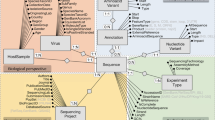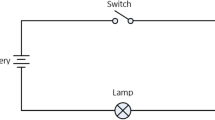Abstract
Inspired by the need to understand the genomic aspects of COVID-19, the Viral Conceptual Model captures and represents the sequencing of viruses. Although the model has already been successfully used, it should have a strong ontological foundation to ensure that it can be consistently applied and expanded. We apply an ontological analysis of the Viral Conceptual Model, using OntoUML, to unpack and identify its core components. The analysis illustrates the feasibility of bringing ontological clarity to complex models. The process of revealing the ontological semantics of a data structuring model provides a fundamental type of explanation for symbolic models, including conceptual models.
Access this chapter
Tax calculation will be finalised at checkout
Purchases are for personal use only
Similar content being viewed by others
Notes
- 1.
The only aspect of the VCM not presented here is the analysis the virus sequence publication. This is due to space constraints.
- 2.
In OntoUML models, we employ the generally-accepted color coding scheme: light red is used for types whose instances are objects, green when instances are relators, yellow when instances are events, and purple when instances are higher-order types.
- 3.
By using the multi-modeling support in UFO/OntoUML, one could proceed further and explicitly capture the relations of subordination between, for example, species and genus, namely, that a type is subordinate to another iff the instances of the former are specializations of instances of the latter [9]. For space reasons, we do not elaborate further.
- 4.
See [11] for an in depth discussion about the semantics of redefinition.
- 5.
Since the Viral Infection is existentially dependent on that particular Animal, then we can infer that the Virus Infected Tissue is also historically dependent on that Animal.
- 6.
Full Consensus Sequence is a type of complete Virus Sequence record. Given the purpose of VCM, these entities are information/representation entities and not the actual chemical structures. In reality, a Full Consensus Sequence is a representation of a virus sequence type that is instantiated by actual complex chemical structures (actual sequences of nucleotides). Making this distinction explicit is beyond the scope of this paper.
- 7.
Molecule Types can be double-stranded or single-stranded. These, in turn, can be positive- or negative-stranded. We restrict ourselves to single-stranded molecule types because the VCM focuses on single-stranded RNA viruses.
- 8.
Once more, Virus Sequences and their proper parts are information objects. Therefore, a Translation event here is not the actual biochemical event involving the real-world counterpart of these entities, but an information processing event that generates Protein representations from Coding Region representations.
References
Al Khalaf, R., Alfonsi, T., Ceri, S., Bernasconi, A.: CoV2K: a knowledge base of SARS-CoV-2 variant impacts. In: Cherfi, S., Perini, A., Nurcan, S. (eds.) RCIS 2021. LNBIP, vol. 415, pp. 274–282. Springer, Cham (2021). https://doi.org/10.1007/978-3-030-75018-3_18
Almeida, J.P.A., Falbo, R.A., Guizzardi, G.: Events as entities in ontology-driven conceptual modeling. In: Laender, A.H.F., Pernici, B., Lim, E.-P., de Oliveira, J.P.M. (eds.) ER 2019. LNCS, vol. 11788, pp. 469–483. Springer, Cham (2019). https://doi.org/10.1007/978-3-030-33223-5_39
Bernasconi, A., et al.: A review on viral data sources and search systems for perspective mitigation of COVID-19. Brief. Bioinform. 22, 664–675 (2021)
Bernasconi, A., Canakoglu, A., Pinoli, P., Ceri, S.: Empowering virus sequence research through conceptual modeling. In: Dobbie, G., Frank, U., Kappel, G., Liddle, S.W., Mayr, H.C. (eds.) ER 2020. LNCS, vol. 12400, pp. 388–402. Springer, Cham (2020). https://doi.org/10.1007/978-3-030-62522-1_29
Bernasconi, A., Ceri, S., Campi, A., Masseroli, M.: Conceptual modeling for genomics: building an integrated repository of open data. In: Mayr, H.C., Guizzardi, G., Ma, H., Pastor, O. (eds.) ER 2017. LNCS, vol. 10650, pp. 325–339. Springer, Cham (2017). https://doi.org/10.1007/978-3-319-69904-2_26
Bernasconi, A., et al.: VirusViz: comparative analysis and effective visualization of viral nucleotide and amino acid variants. Nucleic Acids Res. (2021)
Boyd, K.M.: Disease, illness, sickness, health, healing and wholeness: exploring some elusive concepts. Med. Humanit. 26(1), 9–17 (2000)
Canakoglu, A., et al.: ViruSurf: an integrated database to investigate viral sequences. Nucleic Acids Res. 49(D1), D817–D824 (2021)
Carvalho, V.A., et al.: Multi-level ontology-based conceptual modeling. Data Knowl. Eng. 109, 3–24 (2017)
Carvalho, V.A., Almeida, J.P.A., Guizzardi, G.: Using a well-founded multi-level theory to support the analysis and representation of the powertype pattern in conceptual modeling. In: Nurcan, S., Soffer, P., Bajec, M., Eder, J. (eds.) CAiSE 2016. LNCS, vol. 9694, pp. 309–324. Springer, Cham (2016). https://doi.org/10.1007/978-3-319-39696-5_19
Costal, D., Gómez, C., Guizzardi, G.: Formal semantics and ontological analysis for understanding subsetting, specialization and redefinition of associations in UML. In: Jeusfeld, M., Delcambre, L., Ling, T.-W. (eds.) ER 2011. LNCS, vol. 6998, pp. 189–203. Springer, Heidelberg (2011). https://doi.org/10.1007/978-3-642-24606-7_15
Guizzardi, G.: Ontological foundations for structural conceptual models. CTIT, Centre for Telematics and Information Technology (2005)
Guizzardi, G., et al.: Towards ontological foundations for conceptual modeling: the unified foundational ontology (UFO) story. Appl. Ontol. 10(3–4), 259–271 (2015)
Pastor, O., et al.: Enforcing conceptual modeling to improve the understanding of human genome. In: Proceedings of (RCIS) 2010, pp. 85–92. IEEE (2010)
Paton, N.W., et al.: Conceptual modelling of genomic information. Bioinformatics 16(6), 548–557 (2000)
Reyes Román, J.F., Pastor, Ó., Casamayor, J.C., Valverde, F.: Applying conceptual modeling to better understand the human genome. In: Comyn-Wattiau, I., Tanaka, K., Song, I.-Y., Yamamoto, S., Saeki, M. (eds.) ER 2016. LNCS, vol. 9974, pp. 404–412. Springer, Cham (2016). https://doi.org/10.1007/978-3-319-46397-1_31
Acknowledgements
A. Bernasconi is supported by ERC Advanced Grant 693174 GeCo; V. Storey by J. Mack Robinson College of Business, Georgia State University; G. Guizzardi by the NeXON Project (UNIBZ).
Author information
Authors and Affiliations
Corresponding author
Editor information
Editors and Affiliations
Rights and permissions
Copyright information
© 2021 Springer Nature Switzerland AG
About this paper
Cite this paper
Guizzardi, G., Bernasconi, A., Pastor, O., Storey, V.C. (2021). Ontological Unpacking as Explanation: The Case of the Viral Conceptual Model. In: Ghose, A., Horkoff, J., Silva Souza, V.E., Parsons, J., Evermann, J. (eds) Conceptual Modeling. ER 2021. Lecture Notes in Computer Science(), vol 13011. Springer, Cham. https://doi.org/10.1007/978-3-030-89022-3_28
Download citation
DOI: https://doi.org/10.1007/978-3-030-89022-3_28
Published:
Publisher Name: Springer, Cham
Print ISBN: 978-3-030-89021-6
Online ISBN: 978-3-030-89022-3
eBook Packages: Computer ScienceComputer Science (R0)




